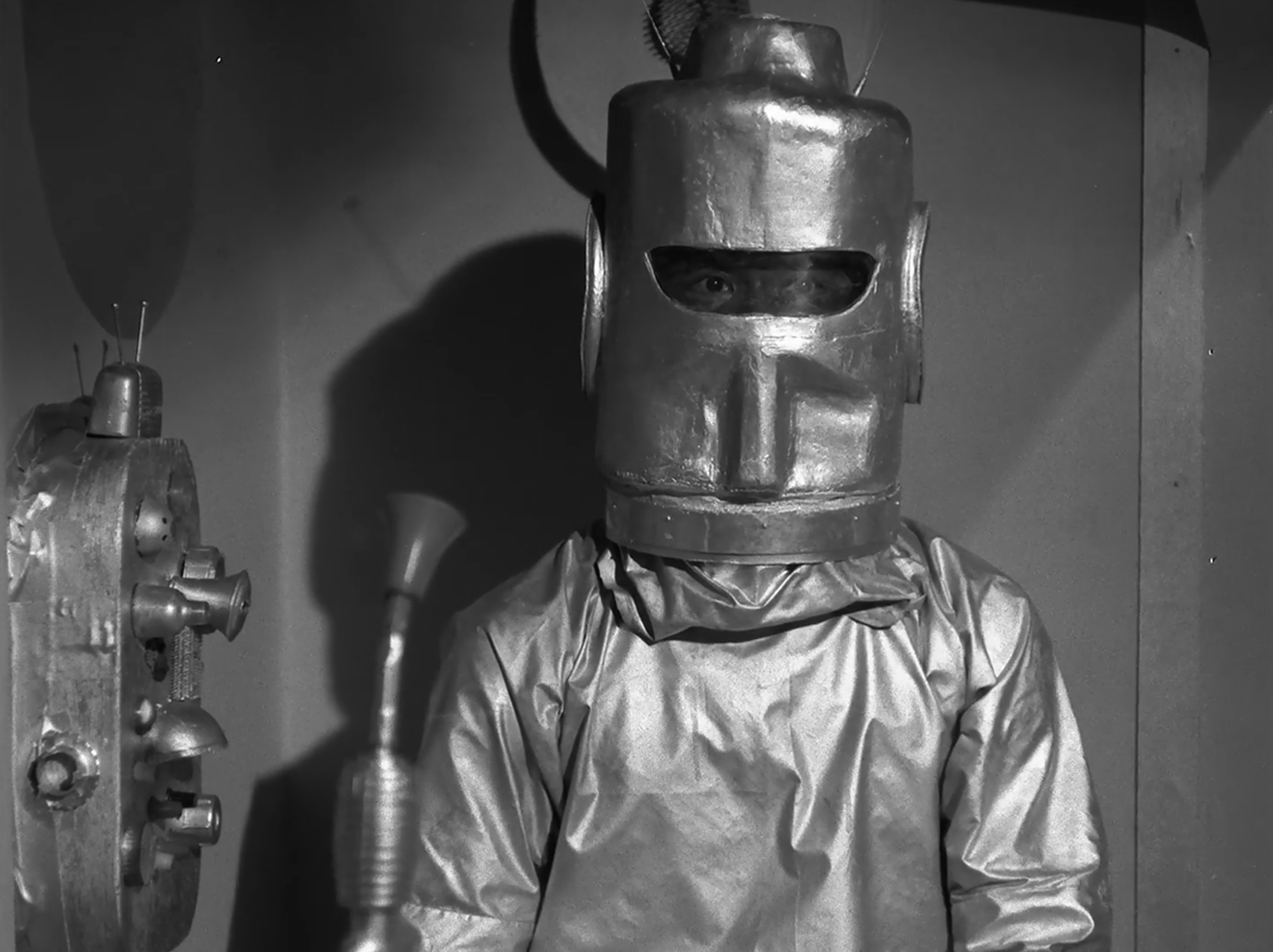
The Brick Dollhouse is so dull and pointless it gets bored of itself. Scenes go on and on until the editor just can’t bear it any longer and resorts to showing a clock on the wall which then dissolves into the same clock several hours later. It’s the cinematic equivalent of “yada, yada, yada.” The film also does the same thing with a candle, several other clocks, and a dissolve from daylight to night. Speaking of daylight what does this character think she is doing?

The film is 98% topless ladies dancing at groovy parties and 2% plot. Fortunately, it has something else going for it. Visually the film is really pretty good. The colors and compositions look a little like they were done by a sexy, pop Ozu. Ok, maybe that is overstating it a bit but I’ll bet I’m the first to use the phrase sexy pop Ozu. See if you can work it into your next conversation.

The Brick Dollhouse uses the Agatha Christie plot structure. We have our detective in a room (a red and white striped room) with the suspects each of whom recalls what happened in a flashback. I think calling it a sexy, pop Rashomon would definitely be pushing it. I don’t want to provoke any unnecessary rolling in the grave on Kurosawa’s part. Anyway, all the flashbacks are the same. All of them recall a party attended by our three female suspects and the murdered female victim. There are quite a few parties. The young ladies seem to do nothing else.
To continue the completely random and unnecessary comparison of the film to Japanese traditions the actors and actresses have a kabuki-like presence on the screen. Their movements and gestures are all stylized and static. When the ladies discover the dead body of their friend it is like a tableaux or a comic book.

The party’s they attend are all the same. Men in suits sit around smoking pot while women without tops dance awkwardly around. I suppose there are worse ways to spend an afternoon but the dancing appears more like the result of ADHD than a desire to get funky. The women seem unable to stand still or do anything other than wiggle. The men manage to barbecue and play bongos between joints but the women are constantly in motion.
The film revolves around a love triangle. Actually, it’s four people so it’s more like a love square, but one side is missing so it's really more like a love “n.” I’ve provided a useful graphic below for ease of comprehension, but this is where the queerness comes in. A love “n” is only possible with at least one participant being gay. In this case, Woman A loves Woman B, but Woman B is cheating on Woman A with Man A who is cheating on Man B. Man B kills Woman C who had nothing to do with anything but happened to look like Woman A from behind because she was wearing a wig. The simplified equation is, Man B killed Woman C, so he could have Man A all to himself.

In order to show homosexual content in 1967, director and producer David F. Friedman had to negotiate his way through the Hayse Code. Images of male homosexuality would never have passed the censors so the sexual scenes are either hetero or lesbian. The male homosexual scenes are just men arguing about their relationship. It seems like a small thing but at the time direct references to male homosexuality were virtually unheard of. Every Tennessee Williams play had to be stripped of any mention of homosexuality before it could reach the silver screen.

There was and is a power dynamic that filmmakers were obligated to maintain. As members of the “underclass” it is acceptable for two women to have sex with each other, but for a man to be on the receiving end of a penis is unacceptable inside a patriarchal society. Being penetrated is seen as emasculating. You relinquish your power and privilege in order to be receptive. As members of the empowered group men look down on and even despise, the women beneath them. Trading in your superior role as a man for the subservient role of a woman undermines patriarchal structure by subverting gender roles, and we can’t have that.
When it comes to homosexuality, and sexuality in general, the Hayes Code invested complete faith in the judgment of the censor. The white, male arbiter of justice has absolute power to determine what is acceptable. Below are the three tenets from the general guidelines.
“1 - No picture shall be produced which will lower the moral standards of those who see it. Hence the sympathy of the audience should never be thrown to the side of crime, wrongdoing, evil, or sin.
2 - Correct standards of life, subject only to requirements of drama and entertainment, shall be presented
3 - Law, natural or human, shall not be ridiculed, nor shall sympathy be created for its violation.”
Terms like “moral standards,” “correct standards” and “natural law” provided carte blanche to exert authority over anything the empowered arbiter didn’t like. There were directors who actually were imprisoned under this ill-defined provision.
Friedman used a tried and true trope that allowed him to include male homosexuals in The Brick Dollhouse. As long as gay men are shamed and then either killed or imprisoned by the end of the film it is acceptable to show that they exist. Women could get away with some same-sex lovin’ as long as we got to see their bedroom shenanigans and those shenanigans adhered to what men thought lesbian shenanigans looked like.
The Brick Dollhouse contains one particularly silly lesbian scene that’s worth mentioning. Two women lie in a bed while one massages the other with a handheld vibrating massage thingy. No, not a vibrator, it looks more like a power sander. The recipient of the power tool wriggles in fits of orgasm while the masseuse continually presses down on her lover’s/victim’s tummy. It is hard to imagine how a power sander-shaped vibrating machine pressed into one’s stomach would elicit an earth-shattering climax but I have the film stills to prove it.

Friedman also benefited from the fact that the Hayes Code was in decline. It would be repealed in 1968, a year after The Brick Dollhouse was released.
I can’t imagine much effort went into making The Brick Dollhouse. I think a few thousand bucks and a weekend would suffice. Friedman went on to make several other films. He worked with Herschel Gordon Lewis on The Adventures of Lucky Pierre, Bloodfeast, and 2000 Maniacs. Friedman produced Space Thing, a completely over-the-top sex romp in space. It’s awful but it’s more entertaining than The Brick Dollhouse. Not having subjected myself to all of the films that Friedman produced I can say that of the 9 or so that I have seen A Smell of Honey, a Swallow of Brine is probably the best. Friedman both wrote and produced it. It’s a nasty little story of a deranged and sadistic woman who enjoys seducing men and then screaming rape when the moment of intimacy arrives. It’s a weird kind of feminist revenge film mixed with a misogynist nudie film. It doesn’t make much sense but the confusion keeps you interested or at least marginally curious.
After the Hayes Code was repealed Friedman also produced movies like Ilsa: She Wolf of The SS which is as offensive as it sounds. People like Friedman had to run wild for a few years after the repeal so they could vomit up all the nasty sleaze they had been choking back for so many years. They stuffed movies full of rape, nazis, incest, graphic violence, and what they termed sexual deviance in a frenzy of free-market capitalist competition.

Once Psycho paved the way for slasher films, and Deep Throat paved the way for porn, the appetite for shocking grindhouse fare subsided. It was splintered and shunted into genres where it intensified in ways directors like Friedman and Lewis could never have dreamed. OK, they definitely dreamed about it but they would have been surprised to see how quickly the industry went from The Brick Dollhouse to Debbie Does Dallas and from Psycho to The Texas Chainsaw Massacre.
The 1970s churned out a morass of bad films to fill seats on 42nd street. This provided a kind of fetid breeding ground of uncensored freedom. It carved out the space necessary for people like Scorsese, Cassavettes, and Waters to experiment with new ideas. It took a childish obsession with sex and violence to pave the way for a wider and more serious expression of the human experience. There would be no Goodfellas, Blue Velvet, or Breaking Bad without ridiculous grindhouse sleaze paving the way for them first.

If you enjoyed this article you might also like
www.filmofileshideout.com/archives/the-erotic-adventures-of-pinocchio



